
Browse an alphabetical list of film clips that feature important events before, during, and after the Holocaust and World War II. These clips include home movies, propaganda films, newsreels, and more.
<< Previous | Displaying results 126-150 of 191 for "Film" | Next >>
In 1933, Nazi Party leader Adolf Hitler became chancellor of Germany and quickly turned the nation's fragile democracy into a one-party dictatorship. Police rounded up thousands of political opponents, detaining them without trial in concentration camps. The Nazi regime also put into practice racial policies that aimed to "purify" and strengthen the Germanic "Aryan" population. A relentless campaign began to exclude Germany's one-half million Jews from all aspects of German life. For two weeks in August…
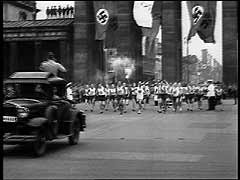
The Storm Troopers (SA) established the Oranienburg camp near Berlin in March 1933. The first prisoners were German political prisoners, primarily Communists and Social Democrats. Oranienburg became known for the maltreatment of inmates. Here, the Nazis attempt to undermine the charges of brutality by showing the "normal" prisoner routine. Oranienburg was gradually deactivated, closing by 1935. Most of the other early camps were also closed, to be replaced with larger camps run by the SS.
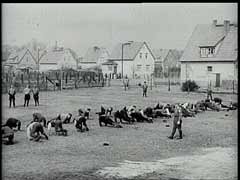
The Soviet Union occupied Lvov in September 1939, according to secret provisions of the German-Soviet Pact. Germany invaded the Soviet Union on June 22, 1941, occupying Lvov within a week. The Germans claimed that the city's Jewish population had supported the Soviets. Ukrainian mobs went on a rampage against Jews. They stripped and beat Jewish women and men in the streets of Lvov. Ukrainian partisans supported by German authorities killed about 4,000 Jews in Lvov during this pogrom. US forces discovered…
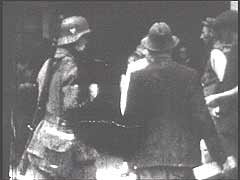
After the sudden death of Franklin D. Roosevelt in April 1945, Vice President Harry S. Truman became president of the United States. Here, President Truman meets with the heads of state of the Soviet Union and Great Britain (Joseph Stalin, Winston S. Churchill, and later Clement Attlee) in Potsdam, near Berlin, to discuss the future of defeated Germany. The leaders agreed to the partition of Germany and Berlin, Germany's capital city, into four zones of occupation: British, French, American, and Soviet.…
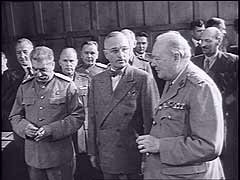
Roma (Gypsies) celebrate with music, dancing, and singing in the mountains near Zagreb, Yugoslavia. During World War II, Roma in Yugoslavia were exterminated by Croatian nationalists and by the Germans.
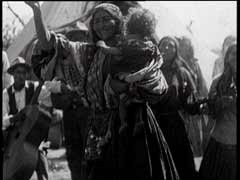
After the Germans established the Warsaw ghetto in 1940, the Jewish council in Warsaw became responsible for the full range of city services inside the ghetto area. In this German footage, prisoners from the ghetto's "Jewish prison" run into the courtyard and walk in circles during inspection.
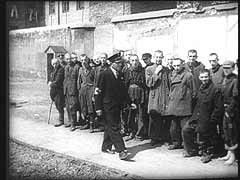
In July 1947, 4,500 Jewish refugees left displaced persons camps in Germany and boarded the "Exodus 1947" in France. They attempted to sail to Palestine without, however, having British permission to land. The British intercepted the ship and forcibly returned the refugees to Germany. This footage shows a protest in the Bergen-Belsen displaced persons camp in the British occupation zone of Germany. The protesters denounced British treatment of the "Exodus 1947" passengers. The plight of the "Exodus"…
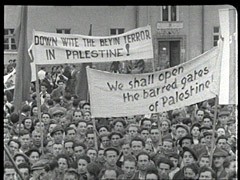
The film "Nazi Concentration Camps" was presented in the courtroom on November 29, 1945, and entered as evidence in the trial. It was filmed as Allied troops liberated the concentration camps. This clip shows the reactions of defendants and others in the courtroom following the screening of the film.
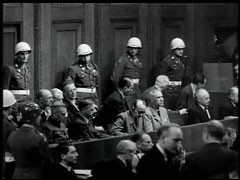
In July 1947, 4,500 Jewish refugees left displaced persons camps in Germany and boarded the "Exodus 1947" in France. They attempted to sail to Palestine although they did not have permission from British authorities to land. The British intercepted the ship and forcibly returned the Jewish refugees to Germany. Here, Jews from the "Exodus 1947" are confined in Poppendorf, Germany. The plight of the "Exodus" passengers became a symbol of the struggle for open Jewish emigration to Palestine.
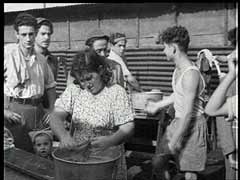
This footage shows the Reichstag (German parliament) building on the day after it was set on fire. While the origins of the fire on February 27 are still unclear, Hitler blamed Communists for the incident. The Reichstag Fire Decree of February 28, 1933, suspended constitutional guarantees. Communist and Socialist deputies were expelled from the parliament. Shortly after the decree was issued, the Nazis established concentration camps for the internment of political opponents.
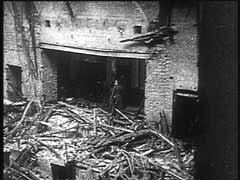
On the night of February 27, 1933, an unemployed Dutch construction worker named Marinus van der Lubbe set fire to the Reichstag (German parliament) building, causing serious damage. The Nazis blamed the Communists for the fire and claimed emergency powers to crush all opposition. Bolstering Nazi claims, the police also arrested three Bulgarian members of the Communist International, who were in Germany at the time, and a leading German Communist. Despite Nazi claims, however, responsibility for the fire…

German forces launched Operation "Barbarossa," the invasion of the Soviet Union, on June 22, 1941. The German army made rapid initial progress in the campaign into Soviet territory. In this German military footage, German soldiers separate women and children from men in a Soviet village.
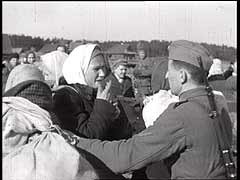
Provisions of the 1919 Treaty of Versailles forbade Germany (defeated in World War I) to station armed forces in a demilitarized zone in the Rhineland—a region in western Germany bordering France, Belgium, and part of the Netherlands. The treaty stipulated that Allied forces—including US troops—would occupy the region. In a blatant violation of the treaty, on March 7, 1936, Hitler ordered German troops to reoccupy the zone. Hitler gambled that the western powers would not intervene. His action…
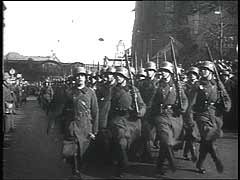
In June 1944, the Soviet Union launched a massive offensive against the German army in eastern Europe. Soviet forces reoccupied Vilna in July 1944, after bitter street fighting with the German garrison. They then continued on toward Kovno, the capital of Lithuania. This Soviet footage depicts the battle for Vilna and the final reoccupation of the city by the Soviet army.

About a million Roma (Gypsies) lived in Europe before World War II. The largest Romani community—of about 300,000—was in Romania. This film shows a Romani (Gypsy) community in Moreni, a small town northwest of Bucharest. Many Roma led a nomadic lifestyle and often worked as small traders, craftsmen, merchants, laborers, and muscians.
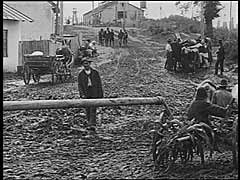
Germany and its Axis allies invaded Yugoslavia in April 1941. The Germans probably shot this film after they occupied southern Slovenia following the Italian armistice in 1943. The film was found in the Ustasa (Croatian fascist) archives after World War II and shows the dismal living conditions that Roma (Gypsies) endured in occupied northern Yugoslavia.
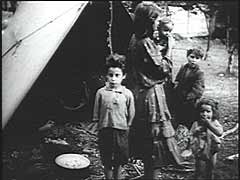
This film excerpt from Groß-Stadt Zigeuner (1932) by filmmaker László Moholy-Nagy shows a Romani (Gypsy) campsite near Berlin, Germany, in the last year of the Weimar Republic. Although Roma (Gypsies) had faced persecution in Germany even before the Nazi rise to power in 1933, the Nazis regarded them as racial enemies to be identified and killed. Tens of thousands of Roma were killed by the Einsatzgruppen in eastern Europe or were deported to killing centers in occupied Poland.
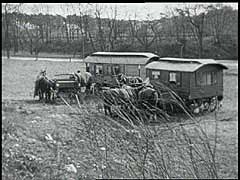
Eva Justin was an assistant to Dr. Robert Ritter, the Third Reich's "expert" on Roma (Gypsies). She studied these Romani (Gypsy) children as part of her dissertation on the racial characteristics of Roma. The children stayed at St. Josefspflege, a Catholic children's home in Mulfingen, Germany. Justin completed her study shortly after this film was taken. The children were deported to Auschwitz-Birkenau, where most were killed.
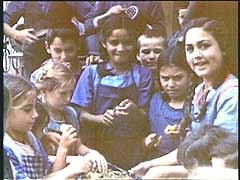
Although constrained by powerful isolationist sentiment in the United States, President Roosevelt was determined to help democratic Great Britain continue the war against Nazi Germany. Even as he promised to keep the United States neutral in the European war, Roosevelt ordered the expansion of military construction and pledged--as shown in this footage--that the United States would serve as the "great arsenal of democracy." In March 1941, Congress approved Lend-Lease aid for Britain. Britain ultimately…
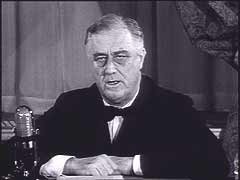
The Buchenwald camp was one of the largest concentration camps. The Nazis built it in 1937 in a wooded area northwest of Weimar in central Germany. US forces liberated the Buchenwald camp on April 11, 1945. When US troops entered the camp, they found more than 20,000 prisoners. This footage shows scenes that US cameramen filmed in the camp, survivors, and the arrival of Red Cross trucks.
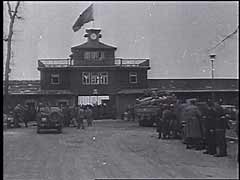
Children from the cheder (traditional religious school) in Munkacs recite their lesson.
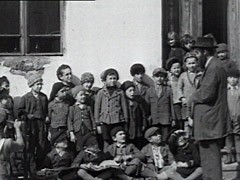
US prosecutor Thomas Dodd introduces the film compilation "Nazi Concentration Camps." At the end of the courtroom scene shown here, the lights are dimmed for the screening. The footage, filmed as Allied troops liberated the concentration camps, was presented in the courtroom on November 29, 1945, and entered as evidence in the trial.
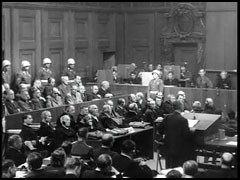

How was the Holocaust possible? The central role of Hitler and other Nazi Party leaders is indisputable. Less well understood is these perpetrators’ dependence on countless others. In countries across Europe, tens of thousands of ordinary people actively collaborated with German perpetrators of the Holocaust. Many more supported or tolerated the crimes. The special exhibition Some Were Neighbors: Collaboration & Complicity in the Holocaust was underwritten in part by grants from The David Berg…
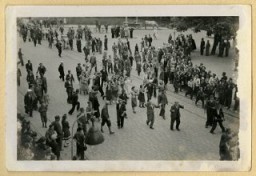
The Germans invaded the Soviet Union in June 1941 (Operation "Barbarossa"). German forces occupied Vitebsk in the northeastern region of Belorussia on July 11. Soviet forces seized the initiative from the Germans after the battle of Stalingrad in late 1942 and early 1943. The Soviet army liberated Vitebsk on June 26, 1944, during their summer 1944 offensive. This footage shows military units involved in the fighting and German soldiers captured during the campaign. By the end of the summer, the Soviet…
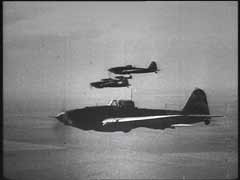
We would like to thank Crown Family Philanthropies, Abe and Ida Cooper Foundation, the Claims Conference, EVZ, and BMF for supporting the ongoing work to create content and resources for the Holocaust Encyclopedia. View the list of donor acknowledgement.